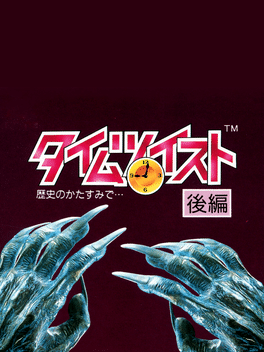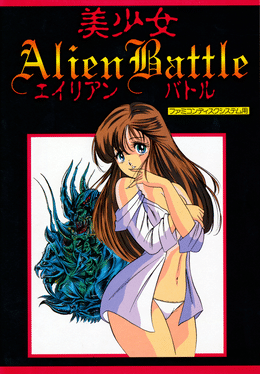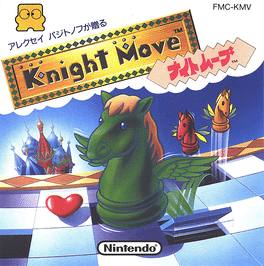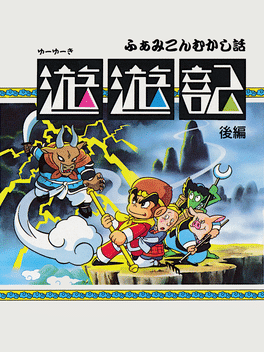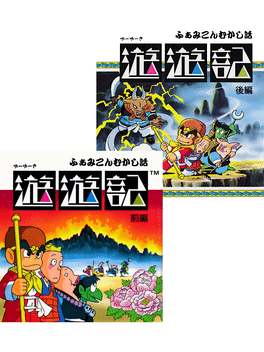New Fds Games
-
Dr. Chaos: Jigoku no Tobira
2016
Dr. Chaos is a side-scrolling action adventure developped by Marionette and published by Pony Canyon. The genius scientist Dr Ginn Chaos has gone missing. Before his disappearance, he was actively working in his large mansion on a device allowing access to alternate dimensions. Armed only with a knife, his brother decides to look for him and ultimately unveil the mystery behind the incident. Something obviously went terribly wrong with Dr. Chaos's experiment, and the goal of the game is to locate all the eleven dimensional warp-zones hidden within the mansion, as well as assembling a powerful laser gun, the only weapon capable of taking down the last boss. Was also released in America for the Nintendo Entertainment System but lacks the saving abilities of the Famicom Disk System version. -
Janken Disk Shiro
1992
Janken Disk Shiro
1992
The sixth and final game featured as the coverdisk of the Japanese Famimaga magazine. Janken Disk Shiro is a block-pushing puzzle game based on the playground game Janken (Rock, Paper, Scissors). Janken Disk Shiro, or Famimaga Disk Vol. 6 Janken Disk Shiro, is a puzzle game in which the protagonist (who looks uncannily like Disk-kun, the mascot of the Famicom Disk System) must brave a labyrinth of puzzles. In each room there are three variants of hand-shaped blocks between the hero and the exit: each one either making the "scissors" gesture, the "rock" gesture or the "paper" gesture. Pushing a block adjacent to another of a different type causes whichever was the inferior (e.g. with paper and rock, rock is the inferior) to vanish. In addition, each block has a "strength" which is signified by its color: green is level 1, yellow is level 2 and red is level 3. If a green block is pushed next to an inferior red block, the red block will instead become yellow instead of vanishing (and then green with a subsequent supe -
Time Twist: Rekishi no Katasumi de...
1991
Time Twist: Rekishi no Katasumi de... is a text-based adventure game developed by Pax Softnica under Nintendo EAD and published by Nintendo for the Family Computer Disk System in 1991. The game was never released outside Japan. Time Twist was sold across two separate discs released on the same day, and completion of the first disc is required to activate the second. -
Time Twist: Rekishi no Katasumi de... - Zenpen
1991
Time Twist: Rekishi no Katasumi de... is a text-based adventure game developed by Pax Softnica under Nintendo EAD and published by Nintendo for the Family Computer Disk System in 1991. The game was never released outside Japan. Time Twist was sold across two separate discs released on the same day, and completion of the first disc is required to activate the second. -
Time Twist: Rekishi no Katasumi de... - Kouhen
1991
Time Twist: Rekishi no Katasumi de... is a text-based adventure game developed by Pax Softnica under Nintendo EAD and published by Nintendo for the Family Computer Disk System in 1991. The game was never released outside Japan. Time Twist was sold across two separate discs released on the same day, and completion of the first disc is required to activate the second. -
Clocks
1991
Clocks
1991
The fourth game featured as a coverdisk on the Japanese magazine Famimaga, Clocks is a Tetris variant in which clock faces must be placed together form larger shapes. Clocks, or Famimaga Disk Vol. 4 Clocks (and occasionally as "Clox"), is a falling blocks puzzle game that is superficially similar to Tetris or Columns. Single clock faces depicting one of four angles fall from the top and the player needs to manipulate and place them so they can form larger objects, such as simple formations like squares, diamonds and hourglass shapes to more object-intensive shapes like octagons and hexagons. The four angles include 180 degree lines ("12:30"), 90 degree lines ("12:15"), 135 degree lines ("~12:22") and 45 degree lines ("~12:07"). Once a clock face is placed, the lines from it extend to connect to any other lines that surround it. Placing lines in such a way that it forms a shape - for example, placing four 90 degree clocks in such a way to form a square - earns the player points and removes the clocks used to form -
Puzzle Boys
1990
Puzzle Boys
1990
Puzzle Boys is the second game in the Puzzle Boy series of 5 games. The first game is the most well known, released as Kwirk on the GameBoy in North America. This is Atlus’s only FDS game, and a late one at that, as the FDS was pratically dead by the time the GameBoy came out. This game improves on Kwirk by adding color, a really fun two player on the same screen mode with the ability to handicap the better player, and way more puzzles in Puzzle Challenge Mode, 80 vs. Kwirk’s 30. -
Wakusei Aton Gaiden
1990
Wakusei Aton Gaiden
1990
A vertical-scrolling shoot 'em up produced by Kokuzeichou: the Japanese equivalent of the IRS. Players are given frequent multiple choice questions while playing. -
Bishoujo SF Alien Battle
1990
You play as a young Japanese schoolgirl, who must defeat an alien super-mind in video poker. -
Backgammon
1990
-
Sexy Invaders
1990
Sexy Invaders
1990
An adult version of the classic arcade game Space Invaders which upon beating levels you get to see various girls undress. -
Knight Move
1990
Knight Move
1990
A puzzle game from Tetris creator Alexey Pajitnov! Featuring of a series of tiles with a single chess Knight, moved by the player. Knock out all the tiles within the time limit using the Knight, only able to move in a L shape. As you clear tiles you will leave holes behind that have to be avoided. On later stages you will have to land on tiles several times before they vanish. -
Gal's Dungeon
1989
-
Mario Bobble
1989
-
Bishoujo Hanafuda Club Vol.2: Koikoi Bakappana-hen
1989
Vol 2 of the adult Famicom Disk System Game released by Super Pig. In this game you play hanafuda versus female opponents and upon winning will slowly undress them. -
Famicom Mukashibanashi: Yuuyuuki - Kouhen
1989
This is the 2nd chapter in this series. Yuuyuki is an adventure game played by choosing from several text commands shown on screen. It resembles its predecessor, Shin Onigashima, in its implementation of the "Change Character" command, usage of traditional Japanese fairytales, and general screen layout and appearance. The story-line is a parody of the Chinese novel Journey to the West, where two main characters, Goku and Chao, embark upon separate journeys to find one another. In Yuuyuki, the "Change Character" command can switch between a maximum of five different characters. However, there are very few points in the game where it can actually be used to such extent. Its main use is to switch between Goku and the others accompanying him. Like Shin Onigashima, the character in use can greatly affect the descriptive text shown on screen, and the significant increase in number of characters allowed for more variety in each scene. It is possible to enjoy the game by viewing the reactions towards choosing completely -
Kattobi! Warabe Ji
1989
Kattobi! Warabe Ji
1989
A baseball RPG/sim in which baseball games are played via cards in a turn-based system. It was released by Pack-In-Video in Japan exclusively. -
Famicom Mukashibanashi: Yuuyuuki
1989
Famicom Mukashibanashi: Yuuyuuki is a 2-part Famicom Disk System game. Yuuyuki is an adventure game played by choosing from several text commands shown on screen. It resembles its predecessor, Shin Onigashima, in its implementation of the "Change Character" command, usage of traditional Japanese fairytales, and general screen layout and appearance. The story-line is a parody of the Chinese novel Journey to the West, where two main characters, Goku and Chao, embark upon separate journeys to find one another. In Yuuyuki, the "Change Character" command can switch between a maximum of five different characters. However, there are very few points in the game where it can actually be used to such extent. Its main use is to switch between Goku and the others accompanying him. Like Shin Onigashima, the character in use can greatly affect the descriptive text shown on screen, and the significant increase in number of characters allowed for more variety in each scene. It is possible to enjoy the game by viewing the reactio -
Famicom Mukashibanashi: Yuuyuuki - Zenpen
1989
Yuuyuki is an adventure game played by choosing from several text commands shown on screen. It resembles its predecessor, Shin Onigashima, in its implementation of the "Change Character" command, usage of traditional Japanese fairytales, and general screen layout and appearance. The story-line is a parody of the Chinese novel Journey to the West, where two main characters, Goku and Chao, embark upon separate journeys to find one another. In Yuuyuki, the "Change Character" command can switch between a maximum of five different characters. However, there are very few points in the game where it can actually be used to such extent. Its main use is to switch between Goku and the others accompanying him. Like Shin Onigashima, the character in use can greatly affect the descriptive text shown on screen, and the significant increase in number of characters allowed for more variety in each scene. It is possible to enjoy the game by viewing the reactions towards choosing completely unrelated characters or commands in certa





